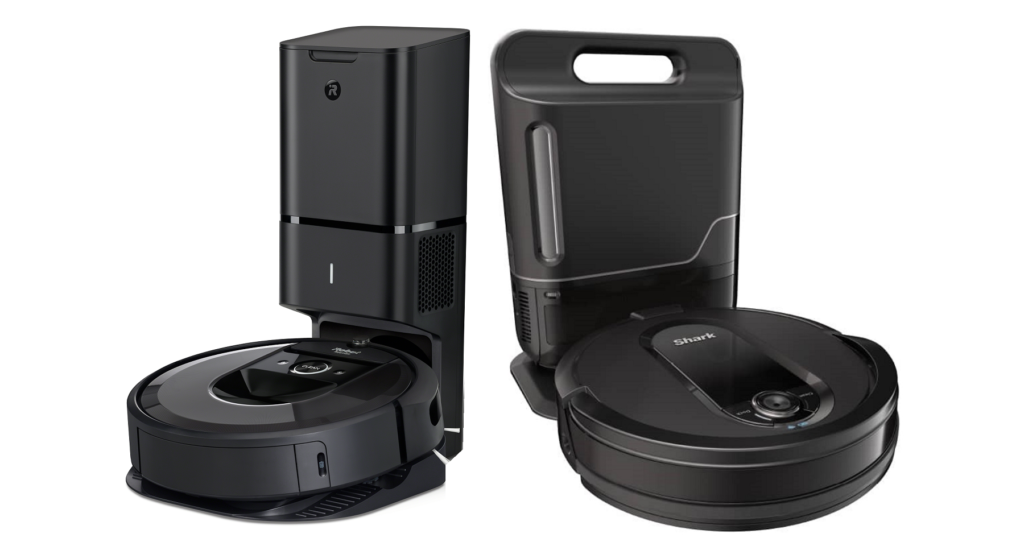While the companies battle over patent rights, the Shark IQ and Roomba i7+ make similar promises to you, the consumer. With technologies making advancements to improve robot vacuum performance, can there be a clear winner?
This article will uncover the differences and compare the similarities of the Shark IQ Auto-Empty (AE) and the Roomba i7+ to find out which model is best for you and your floors. Find out which robot is best for your home here.
Click here for a comparison of different models of Shark vs Roomba broken down by category.
Contents
- 1 Differences between Shark IQ Robot Self-Empty and iRobot Roomba i7+
- 2 Similarities
- 3 Specifications Chart
- 4 Comparing the Roomba i7+ and the Shark IQ Self-Emptying Robot
- 5 Best Features and Options
- 6 Shark IQ vs Roomba i8+
- 7 Frequently Asked Questions
- 7.1 Q. What is the warranty period of the robots, and how do I make a claim?
- 7.2 Q. How do I contact iRobot customer support?
- 7.3 Q. How do I contact Shark customer support?
- 7.4 Q. Will the high-efficiency filters collect as much as a HEPA filter?
- 7.5 Q. Will either the Shark IQ or Roomba i7 have difficulties with crossing thresholds?
- 7.6 Q. Are either the Shark IQ AE or the Roomba i7+ able to upgrade?
- 8 What I Like about the Roomba i7+
- 9 What I Like about the Shark IQ Robot
- 10 Conclusion
Differences between Shark IQ Robot Self-Empty and iRobot Roomba i7+
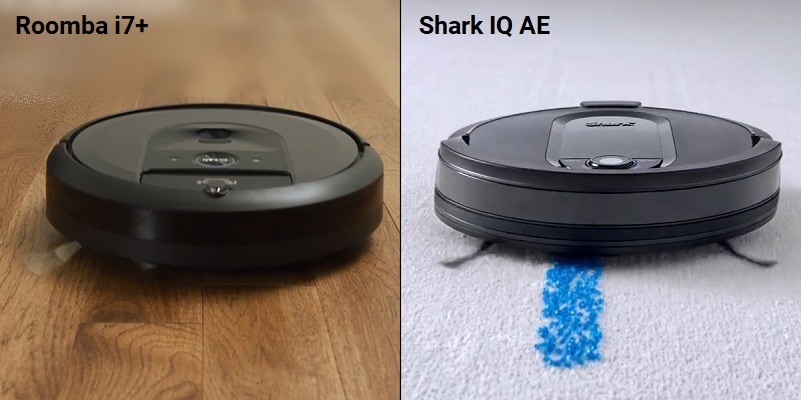
With so many features and options being the same, it can be hard to distinguish what aspects of the robots, if any, are different. Let’s take a look at the differences now.
- The Shark IQ uses a combination roller with bristles and rubber paddles. The i7+ uses dual-rubber extractors that have no bristles.
- Side Brushes. Roomba has a single side brush with multiple bristle tips, while the Shark robot has two edge brushes, each with only one set of bristle sweepers.
- Shark uses virtual containment through their app (some portions still being tested) and physical containment with Bot Boundary Tape. Roomba also uses virtual containment with newer features being released soon, as well as a dual-mode virtual wall barrier.
- Shark’s IQ AE has a battery life that will run for up to 60 minutes per charge. The Roomba i7+ will run for about two hours per charge.
- Imprint Technology. Imprint Smart Mapping and Imprint Link are two features exclusive to the Roomba i7 and s9 models. Shark doesn’t have robot linking technology.
- Carpet boost. Roomba uses a feature called caret boost that increases motor speed and suction power when the robot is cleaning carpet. Shark IQ AE doesn’t use a carpet boost feature.
- The Roomba i7+ has a price tag at least twice that of the Shark IQ AE.
Similarities
Now that we have seen the differences, let’s take a look at some of the technology and options the two robots have in common.
- Automatic collection bin emptying. The Shark IQ and Roomba i7+ both automatically empty their collection bins into the charging stations when they dock after cleaning or to recharge the batteries.
- Navigation Technologies. Both vacuums use vSLAM technology to map your floor plan with cameras and infrared sensors accurately.
- Recharge and Resume. When the batteries get low, both robots will stop cleaning and return to the charging stations to top off the batteries. When the batteries are recharged, each will resume cleaning right where it left off.
- High-efficiency filtration. Both robot vacuums come with HEPA quality filtration that will reduce in-home allergens.
- Wireless communications. Each robot has the ability to connect to your home wireless network allowing you to use mobile apps and voice commands.
Specifications Chart
Let’s see how the two robots stack up side by side in this handy specifications chart.
| Roomba i7+ | Shark IQ Robot Self-Empty | |
| Size | 13.34×13.34×3.63 | 12.9×12.6×3.5 inches |
| Weight | 7.44 pounds | 5.87 pounds |
| Navigation | iAdapt 3.0 | vSLAM |
| Battery | Lithium-Ion | Lithium-Ion |
| Runtime | Up to 120 minutes | Up to 60 minutes |
| Charge Time | 3 hours | 3 hours |
| Automatic Recharge | Yes | Yes |
| Entire Level Clean | Yes | Yes |
| Filter | High-efficiency | High-efficiency |
| Carpet Boost | Yes | No |
| Drop Sensors | Yes | Yes |
| Bump Sensors | Yes | Yes |
| Dirt Detection Sensors | Yes | No |
| Camera Navigation | Yes | Yes |
| Wireless Communications | Yes | Yes |
| Mobile App | Yes | Yes |
| Voice Controls | Yes | Yes |
| Floor Types | All | All |
| Imprint Smart Mapping | Yes | No |
| Imprint Link | Yes | No |
| Room Select Cleaning | Yes | Yes |
| Keep Out Zones | Yes | No |
| Collection Bin Capacity | 0.6L | 0.6L |
| Washable Collection Bin | Yes | No |
| Automatic Collection Bin Emptying | Yes | Yes |
| Side Brushes | 1 Side Brush | 2 Side Brushes |
| Containment | Dual-Mode Virtual Wall Barrier | Bot Boundary Tape |
| Warranty | 1 Year | 1 year |
| Price | Check on Amazon | Check on Amazon |
Comparing the Roomba i7+ and the Shark IQ Self-Emptying Robot
Now we will dive inside the two robot vacuums to find out what makes them work, how those features compare to one another, and which one is the best fit for you.
Basics of Operation
All robot vacuums have the same necessary materials used for their operation. For instance, the Shark IQ and Roomba i7 use a lithium-ion battery to power all modes and parts of the robots. The Roomba does have a battery with twice the longevity, but with their automatic recharging capabilities and the fact they resume cleaning, the battery runtime doesn’t matter too much.
The robots also have extractors to agitate carpeting, lift and separate debris and sweep hard flooring. Because of patent rights, the Roomba i7+ uses twin brushless extractor bars. The soft rubber paddles are safe for all flooring and adept at getting deep into carpet fibers.
The Shark IQ uses a single extractor that is a combination of rubber paddles for sweeping hard flooring and bristles for agitating carpet. Both models are adept at staying clear of string and hair tangles. The Shark uses a stationary brush that keeps the rotating extractor clear of debris. Roomba’s twin extractors separate the string, hair, and larger debris from each other.
The collection bins are also another staple of robot vacuums. Both of these models use a 0.6L capacity collection bin where they deposit the dirt and debris they collect. Each robot also has a filter to keep the motor area clean and purify the exhaust air that returns to your home.
The filters are high-efficiency, HEPA style filters that collect in-home allergens. The filters for these two robots are efficient at capturing small particles, including pollen, dust mites, pet dander, and mold spores.
Bottom Line: For basic operational items, the two robots are quite equal. However, the extractors are slightly better with the Roomba model, and therefore, the i7+ gets the nod.
Performance Enhancers
Both the Shark IQ Self-Emptying Robot and the Roomba i7+ have technologies and features that make their cleaning and operation even better. For starters, both robots have wireless communications. Once connected to your home wireless network, the WiFI enabled robots are opened up to alternative control methods.
Mobile Apps and Voice Commands
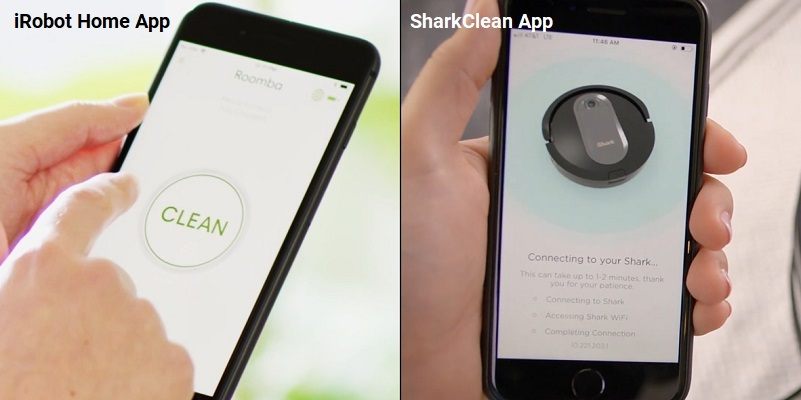
You can download the iRobot Home app or the SharkClean App to set up and control your robots. Scheduling, programming, cleaning maps, and status information can be found on both of the apps.
If that isn’t enough, you can use your Amazon Alexa or Google Assistant devices to control your robots with voice commands. Most of the same control options (minus viewing the maps) from the mobile apps are available for voice control.
You can also use your voice to tell both robots to clean or avoid certain rooms in your home. This method of single-room cleaning will be set up in the mobile app and used by voice controls.
Navigation and Mapping
The two robots use visual Simultaneous Localization and Mapping (vSLAM) for navigation. The camera and sensors scan your home, taking pictures, and building three-dimensional maps. These maps are displayed on the mobile app but are also used by the robots to know where they are going, where they have been, and what is left to clean.
Both robots will scan the home and use cameras to create a visual map. The vSLAM algorithms create the map in the robot’s memory, allowing them to move through your home without the worry of damage.
The Roomba i7+ uses Imprint Technology to store and use the maps. This technology allows the robot to scan, create, and store up to 10 maps at a time. Shark IQ AE will only store a single map at a time. Any changes will to the layout or location will require another mapping run. The Imprint technology also allows the i7+ to communicate with the mopping robot, Braava M6.
With the maps on both mobile apps, you can control which rooms the robots will clean. By selecting the rooms, you use a form of virtual containment (discussed below) to tell the robots the rooms of the map that are accessible for cleaning.
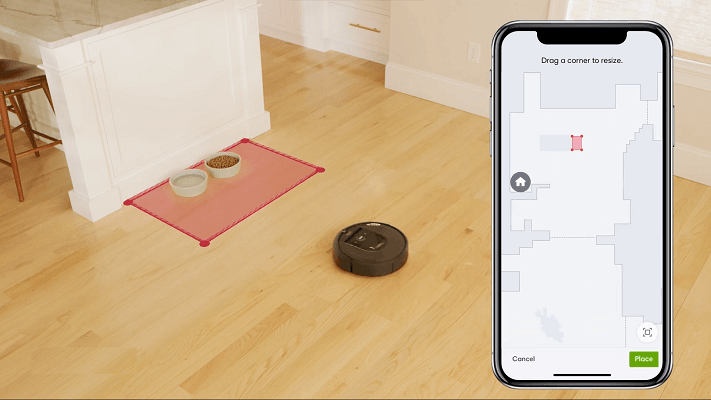
Roomba has also released a feature known as Keep Out Zones. Instead of blocking entire rooms, you can click, drag, and draw squares within a room that the robot will avoid. Shark IQ doesn’t have the Imprint Link technology (no mopping robots to communicate with), nor does it have Keep Out Zones.
Bottom Line: Both the navigation and mapping of the two robots are similar and work in much the same respects. Roomba offers a bit more features in the mapping arena and gets the checkmark for this round.
Performance Expectations Vs. Reality
It is easy for manufacturers to place their robots in extremely controlled environments, sprinkle light debris around the floors and tell us how well they clean. Let’s face it, though; those cereal bits dropped on the carpet this morning are going to get crunched and ground in before you ever notice them.
Finding out how robot vacuums perform in real-world scenarios is much more telling of their actual abilities. Let’s find out what really happens when these little guys start cleaning your home.
Cleaning Carpets
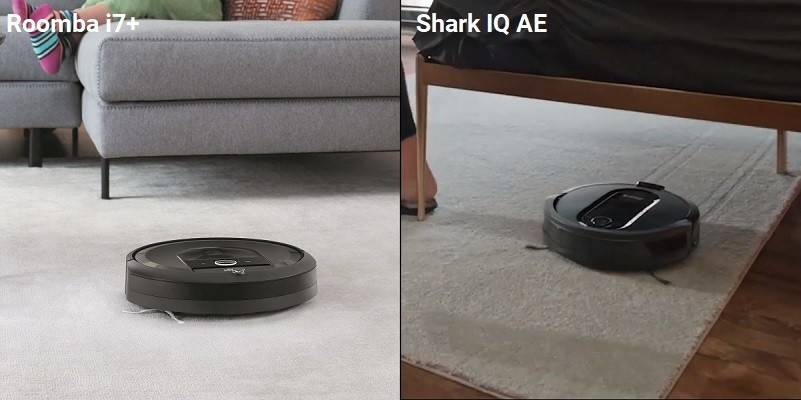
On carpeting, both the Shark and Roomba vacuums are quite capable. Each one will easily tackle low, medium, and high-pile carpeting. This includes throw and area rugs. The main difference comes in how well they clean.
The Shark IQ AE won’t have any issues getting most, if not all, of the dirt and debris from low pile carpeting. Medium-pile carpeting will have faint traces of smaller and heavier debris left behind. Things like sugar and ground bits of food may remain deep in the fibers. The same is true for high-pile carpeting.
Because of the single extraction roller, the carpet fibers won’t get agitated as deep down as the Roomba models get. The i7+ uses carpet boost to increase the suction and motor speed when the robot is on carpeting, resulting in a deeper clean.
Even high pile carpet gets cleaned down to the carpet base. With the dual extractors and no bristle brushes, the Roomba i7+ won’t get bogged down or tangled on the longer fibers.
When it comes to fringe, power cords, toys, and other debris that shouldn’t be collected, the Roomba will roll over them and attempt to suck them up. However, once it becomes tangled, the extractors will reverse themselves, trying to free itself. If successful, it will continue cleaning, avoiding the obstruction.
The Shark will also run over the debris and try to collect it, including rug fringe and power cords. If it does get tangled, though, it won’t attempt to free itself. Instead, it will shut down to avoid damage and alert you that there is a problem.
Cleaning Hard Flooring
The robots are pretty much equal when cleaning hard flooring. Both models will clean hardwood, softwood, tile, laminate, and vinyl. Neither model will scratch softer surfaces, either, so there is no worry about letting them go where they are needed.
The one difference is cleaning along edges and getting into corners. The single side brush of the Roomba i7+ does an excellent job of getting your baseboards clean, but it does struggle some in corners. The design of the robot doesn’t allow it to get deep into corners, so if you have a lot of build-up in the corners of your home, you may need to sweep them out manually.
The Shark, on the other hand, has two side brushes. While they only have a single set of bristles each, they do a complete job of gathering debris for the extractors. Once again, though, when it comes to getting in corners, the Shark falls a little short. The round design of the robots prevents their complete entrance into right angles.
Pet Hair, Long Hair, and String
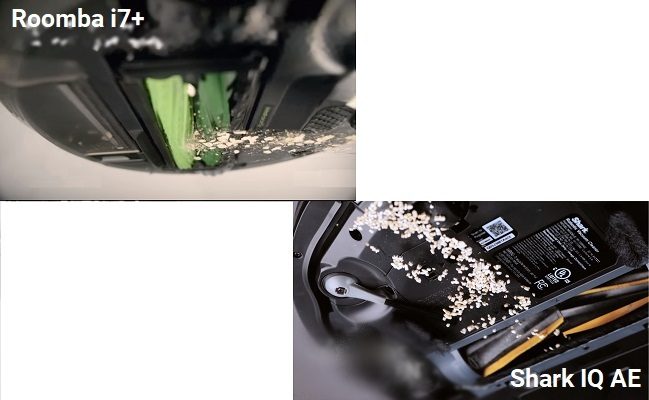
With the Shark IQ AE having a brush fashioned in place to clean the brush roller and the Roomba using the twin extractors, neither of them accumulates much in the way of tangles or wrapped hairs around the extractors.
Now, to say neither will ever get wrapped is false. They are spinning parts collecting long bits of pet fur, human hair, and strings. Things will get wrapped. However, both robots are capable of preventing most tangles.
The Shark IQ uses the stationary brush to separate hairs as they begin to get wrapped. The suction takes care of the rest. Roomba’s i7+ separates individual strands with the counter-rotating extractors. Both models are ideal options for homes with shedding pets.
Bottom Line: The slight edge in real-world cleaning will go to the Roomba i7+. While being equal with hair and hard flooring, the carpet boost technology of the Roomba means it cleans carpeting slightly better.
Best Features and Options
With the basic operations and real-world cleaning out of the way, let’s take a look at the unique features that make these two models stand-outs in the crowd.
Automatic Bin Emptying
The Roomba i7+ was the first model on the market with a self-emptying collection bin. There is a hole in the collection bin (covered with a rubber flap). When the robot docks on the Clean Base charging station, the hole is recognized, and the motor inside the Clean Base kicks on. The debris is suctioned out of the collection bin and deposited into a vacuum bag that fits inside the tower.
Shark has a similar setup, except that the Shark IQ AE doesn’t use a vacuum bag to store the collection, instead just depositing it into the tower that doubles as a bagless canister. To empty, you remove the tower, hold it over the garbage can and release the bottom. The debris will fall out into the garbage.
[easyazon_image align=”none” height=”500″ identifier=”B07S864GPW” locale=”US” src=”https://smartrobotichome.com/wp-content/uploads/2019/11/41mMxYMO2B1L.jpg” tag=”srh-easyazon-20″ width=”500″]
[easyazon_image align=”none” height=”500″ identifier=”B07GNPDMRP” locale=”US” src=”https://smartrobotichome.com/wp-content/uploads/2019/11/51fcqOV6w2L.jpg” tag=”srh-easyazon-20″ width=”500″]
Both towers will hold about a month’s worth of collection bin debris. With the Roomba, you pull the full bag out of the tower and toss away. While the Shark is a more ecological answer, it is harder to clean. You can’t soak it or submerge it in water, so you have to manually wipe it out with a damp towel and dry thoroughly.
Containment Options
Roomba and Shark both offer you multiple containment options. If you want to prevent access to entire rooms, portions of rooms, or just random items on the floor within those rooms, you can.
For Shark, there are two options. The first is the standard Bot Boundary tape. This is a roll of magnetic tape that you will cut to size to cover thresholds, place around pet food dishes, or to separate portions of rooms. When the robot gets near, the magnetic tape alerts the robot and causes it to change direction.
The other option is the virtual containment. Through the mobile app, you can highlight specific rooms to mark them unavailable. The map will then be uploaded to the robot on the next cleaning session, where it will avoid the rooms marked off on the map.
Roomba has a similar interface with the mobile app. Once the mapping runs are completed, you can go through and correct any mistakes. For example, on rare occasions, the mapping won’t connect a wall. You can then name the rooms and make entire rooms to be cleaned or to be avoided.
You can also use a new feature being pushed out as of October 2019. The new feature, known as Keep Out Zones, is available for the Roomba i7 and s9 models. With this feature, you will be able to create squares of any size in any room. The robot will avoid these locations.
For instance, you can mark on the map where you keep the dog food bowls. Using the Keep Out Zones, you can draw a small rectangle around the area on the map, and the robot won’t go near them.
If that isn’t enough, you also have a dual-mode virtual wall barrier that comes with the purchase. These battery-operated towers use infrared lights to prevent the robot from crossing over. You can add more virtual walls if you prefer, as they are sold in singles or multiple-packs.
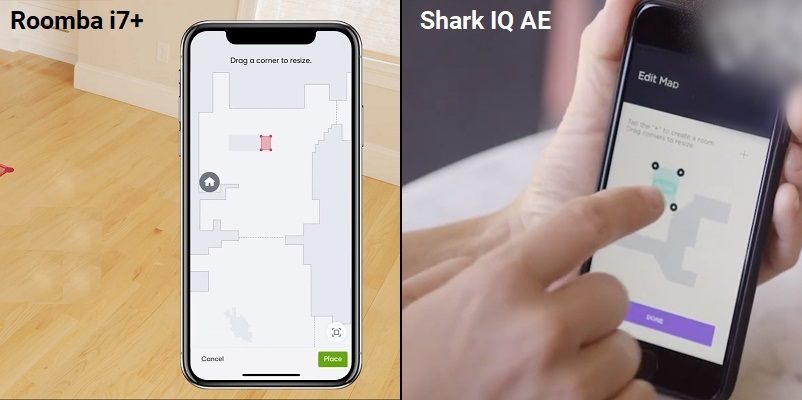
Bottom Line: This is a tie as each is better at one of the features than the other. Roomba has better containment in both the mobile app and physical sense. However, because of the bagless collection bin storage of the Shark IQ, it is more eco-friendly and easier to empty.
Shark IQ vs Roomba i8+
The Roomba i8+ is Costco’s version of the Roomba i7+. It comes with extra accessories in the box over the i7+.
With the Roomba i8+, here’s what you get: 1 virtual wall barrier, 2 extra Roomba filters, and 4 disposal bags. Other than the extra accessories, the i8+ robot vacuum itself is exactly the same as the i7+. Therefore, every difference discussed in this article also applies to the i8+.
To summarize: The Roomba i8+ is better than Shark IQ when it comes to cleaning performance and mapping. The Shark IQ is more eco-friendly because its collection bin is bagless, but is a bit less sophisticated in its navigation.
The two vacuums use different methods of containment, the Roomba i8+ uses keep out zones and the virtual wall barrier accessory, whereas the Shark IQ robot uses the bot boundary tape to keep it away.
Frequently Asked Questions
Let’s take some time now and answer a few of the more commonly asked questions. If your question is still unanswered, feel free to use the comments section below.
Q. What is the warranty period of the robots, and how do I make a claim?
A. Both robots offer you a 1-year warranty to protect your purchase against manufacturers defects, problems with the batteries, motors, or other non-replaceable parts. Wheels, extractors, filters, and side brushes are not covered.
Roomba also offers you a 60-day return period where you can try the robot without worry, and return it for any reason if you aren’t satisfied. To make a claim for Roomba, you need to visit the claim center page to make sure you meet the requirements. For Shark, their warranty page will detail everything you need to know, have, and do to make an official claim.
Q. How do I contact iRobot customer support?
A. You can call, toll-free, 1-800-727-9077. If you would like to reach customer service through email or live chat options, you can find the needed information and chat links on their customer support page.
Q. How do I contact Shark customer support?
A. You can contact SharkNinja customer support by calling 1-888-228-5531.
Q. Will the high-efficiency filters collect as much as a HEPA filter?
A. The term high-efficiency is, in fact, a HEPA filter. HEPA is a designation for certification that most manufacturers don’t strive to acquire any more. However, the filters are the same and will capture practices down to 3 microns in size. This allows everything but the smallest bacteria (generally measuring 2 microns) from water and swimming pools, to be captured in the filter material.
Q. Will either the Shark IQ or Roomba i7 have difficulties with crossing thresholds?
A. For the most part, your doorway thresholds will be traversed with ease by either robot. However, there are instances where some thresholds are wider and taller in the middle. These step-style thresholds may prove difficult for the robots to cross over. If the threshold is less than ¾ inch tall and less than six inches wide, there shouldn’t be any problem at all.
Q. Are either the Shark IQ AE or the Roomba i7+ able to upgrade?
A. Actually, no. The Shark IQ AE and the Roomba i7+ are the upgraded versions. You can opt for the Roomba i7 instead of the Plus model, which will not have the auto-emptying collection bin or Clean Base charging station. The Shark IQ (non-AE model) will also be without the auto-emptying feature and tower. However, the Shark IQ also has a smaller collection bin, less power, and a few other cosmetic differences.
What I Like about the Roomba i7+
- Imprint Smart Technologies allows the robot to clean more efficiently and communicate with the mopping robot.
- Long battery life; running the robot up to 2 full hours per charge.
- An automatic emptying collection bin means hands-free operation for up to a month.
- Wireless communications make programming and control easier.
What I Like about the Shark IQ Robot
- Bagless automatic emptying of the collection bin is eco-friendly.
- Virtual containment allows you to avoid using the Bot Boundary tape.
- Two side brushes allow for cleaning along the edges in any direction.
Conclusion
For everything covered in this article, the Shark IQ AE and Roomba i7+ are quite comparable. The smaller differences where the Roomba beats the Shark vacuum can be negated by the cost of the much less expensive Shark IQ.
Both models will clean all floor types, allow multiple control options, and scheduling from anywhere at any time. If you have a lot of carpeting, the carpet boost feature found in the Roomba models might serve you better. However, if you are looking to save some money, the Shark IQ is a decent option as well.
Click here for all the robot vacuum deals on Amazon today.
